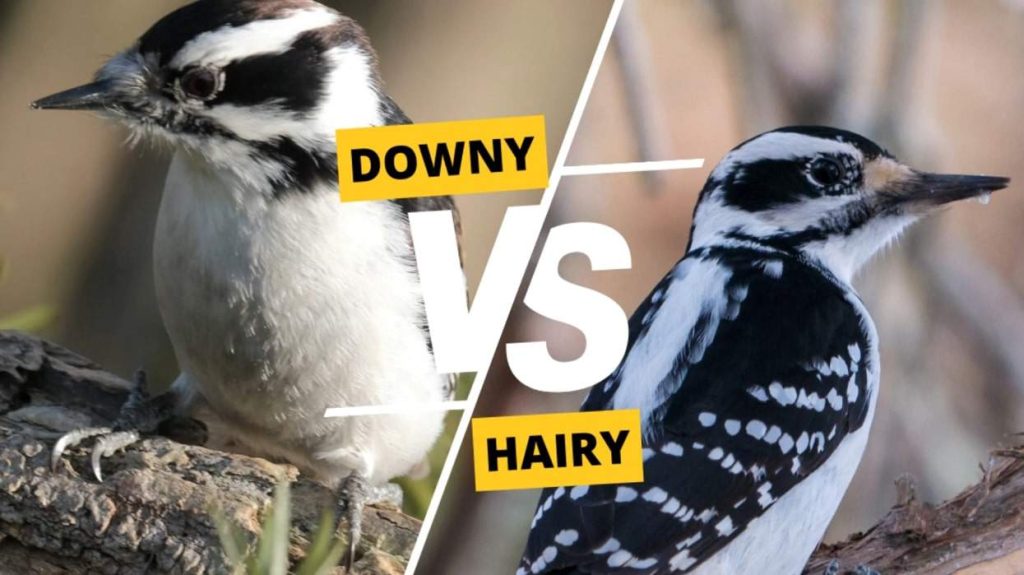Describing a woodpecker as white, black, and red might lead you to think of either the downy or the hairy woodpecker.
This is where the problem lies: These two woodpeckers are so similar in many ways that it’s hard to tell them apart.
Both share a fondness for pecking at wood and creating a racket.
You might have mistaken one for the other at a glance, believing them to be the same species. However, I can confirm they are distinct from each other. Find out why!
Habitat Preferences
Let’s look at their living preferences: habitats.
Despite their similar appearances, these woodpeckers have distinct habitat preferences.
The downy woodpecker is notably more common in smaller communities such as villages.
It often nests in smaller trees like baby birches or among cattails, which can even be found in people’s gardens.
On the other hand, the hairy woodpecker prefers the solitude of larger trees and deeper woods, making it less likely to disturb your peace.
So, if you’re deep in the forest on a hike and catch sight of a woodpecker, chances are it’s the hairy variety rather than the downy.
Size

Despite similar coloring, there is quite a difference in the size of these two woodpeckers.
If they’re not next to each other, it’s probably hard to see, but the hairy woodpecker is the larger of the two.
The downy woodpecker is a little over six inches long, but the hairy usually comes in around 50% larger. Bill size is also different.
The downy’s bill is also very small and about one-third the length of its head. On the other hand, the hairy is much more impressive with a long, spiky bill.
Diet
When it comes to diet, there’s not a huge difference between the two – although I wouldn’t fancy what they have.
Both woodpeckers tend to eat insects and insect larvae as their primary food.
Seeds are also welcomed by their stomachs, but they mainly forage in the sides of trees and the tree bark to find ants and beetles.
The only real difference is that downy woodpeckers tend to seek much smaller insects just below the bark.
Hairy woodpeckers, with their longer bills, can reach deeper into the tree for larger insects and larvae. It’s a bit of a showoff.
Sound
We all know that birds have distinctive calls—even those without a keen ear can still tell the difference between a crow and a blackbird.
But the hairy and downy woodpeckers have only very subtle differences in their calls. The hairy woodpecker makes a short, sharp peak note whenever it calls.
This is not much different from the downy woodpecker, only that it’s slightly lower in pitch. So you’ll have to do a lot of listening to be able to tell.
Hairy woodpeckers can also rattle or whiny; the only difference is that the pitch drops at the end, whereas the downy’s don’t.
Fledglings
This makes it even harder to differentiate between their fledglings.
Downy and hairy male woodpeckers have a red patch on the back of their heads.
When they are babies, the patch is on their heads, but sometimes, in the case of hairy woodpeckers, it can be a captivating yellow.
Fledglings may also have extra black marks on their sides or white back stripes, so they are very beautiful-looking birds.
Lifespan
The average lifespan of a woodpecker is around 10 to 15 years. Due to the hairy woodpecker’s larger size, it is known that they live longer than the downy on average.
A hairy woodpecker averages around 13 to 15 years old.
So there isn’t a big difference, but due to the downy’s smaller size, likely, they live closer to the ten-year mark. Still, that is a decent time for such a small bird.
FAQs
How Rare is it to See a Downy Woodpecker?
The downy woodpecker is not too rare to spot compared to the hairy.
Due to the hairy woodpecker’s preference for denser woodland, you would have to go out of your way hiking to catch sight of one.
The downy, however, is much more frequent, especially if you have plenty of bird feeders in your garden.
The Downy does not mind venturing into built-up country areas (like villages) and could quite easily come for a little nibble on some seed if you happen to have some in your garden.
Are Downy Woodpeckers Friendly?
Many animals instinctively shy away from humans. The moment you step into your backyard, it’s common to see birds take flight.
However, the downy woodpecker gradually becomes accustomed to human presence. Over time, it grows comfortable enough to venture into gardens for feeding.
Unlike some creatures, it remains unfazed by people watching it dine and doesn’t show aggression towards other birds.
This makes the downy woodpecker an exceptionally agreeable guest to have feeding in your garden.
Final Thoughts
And there you have it – the key differences between these very similar woodpeckers.
At first glance, what might seem like identical birds, actually lead completely different lives in terms of habitat.
Their size ranges, with the hairy woodpecker’s bill being much longer, creating slightly different diets between them and the downy.
Insects are always on the menu for these two woodpeckers, but smaller beetles and ants are much more favored by the downy woodpecker.
So next time you look out into your garden and see a red, black, or white woodpecker, you can be certain that it’s a downy woodpecker—as they are much more content in people’s gardens than the forest-dwelling hairy woodpecker.

